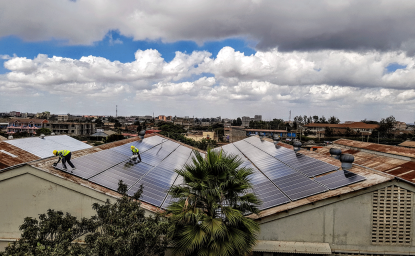Chapter 15 Update: North America
Significant changes in the North American energy landscape have occurred since early 2013 when we wrote a chapter in Energy and Security: Strategies for a World in Transition. The long hoped for constitutional reform in Mexico has opened the energy sector to new private and foreign investment for the first time in 75 years. The world oil price, then above $100, has since collapsed. Clean energy policy developments in the U.S. and Mexico could become drivers for even further continental energy market integration.
Mexican Energy Reforms
In December 2013, the Pena Nieto government led a constitutional reform to allow private investment and competition in the energy sector. Secondary legislation was enacted the following summer laying out the framework for investment in the oil and gas production, refining and pipeline sectors. Opening the electric power sector to competition, including a clean energy standard, was also part of the reform wave.
By the time of the first auctions in July 2015, oil prices had fallen by over one third, from $110 per barrel for the Brent benchmark crude at the time of the initial reform to below $60 per barrel. The first round of tenders was aimed at expanding oil production for revenue purposes. The first auction, for exploratory plays, was a disappointment with only two blocks awarded. To avoid a repeat in the second auction, the National Hydrocarbons Commission (NHC) addressed some of industry’s concerns with regard to schedule and fiscal terms prior to offering shallow water blocks previously explored by Pemex. In December 2015, the government announced it was postponing the auction for the deep water exploratory blocks until later in 2016 due to the low price environment. Those blocks, in the region next to the U.S. maritime boundary, are of most interest to the global oil companies with the expertise and capital to explore and develop such projects. The challenge for the Mexican government will be to gain industry confidence that it offers a stable, profitable business environment with competitive contract and fiscal terms at a time when capital budgets are being slashed across the industry.
The other major element of the energy reform transforms the Mexican electricity market. Once the sole domain of the Federal Electricity Commission (CFE), the market is now under an independent system operator, the National Center for the Control of Energy (CENACE), with independent power producers allowed to contract with CFE or bid against it. CFE will create transmission, distribution, supply and generation subsidiaries, each of which will be managed separately, to compete with new entrants in the restructured market. Mexico is counting on investment in natural gas to replace high cost oil fired generation. The volumes of natural gas from the Eagle Ford and Permian basins in Texas flowing into Mexico have been increasing rapidly, more than doubling in the last two years with more pipeline capacity planned and under construction. As implementation of the electricity reforms proceeds those volumes are expected to increase significantly.
Source: U.S. Energy Information Administration
The electricity reform also included a clean energy target of 35% of all generation from renewables and nuclear (zero greenhouse gas emission sources) by 2024. The Energy Ministry (SENER) scheduled auctions for new transmission and 20-year renewable energy certificates in early 2016. CFE, which is responsible for covering at least 5% of its customers' electricity demand with clean energy in 2018, will offer 15-year contracts for energy and power from third party sources. Future rounds will be open to third party procurement of electricity from power suppliers independent of CFE. The clean energy aspect of the reform, coupled with commitments to reduce greenhouse gas emissions made at the Paris conference, is already stimulating investment in renewable equipment manufacturing facilities in Mexico.
Most of the electricity trade between the United States and Mexico has been between Southern California and Baja California. The rest of the border is limited to interties serving border towns due to non-synchronous, low capacity lines. How much and how fast the cross border trade grows will depend on more complex technical challenges to harmonize the grid.
Collapse in Oil Prices
The collapse in oil prices has had and will continue to have an impact across the continent.
United States: U.S. crude oil production had increased steadily for a decade until the low price environment of 2015 caught up with producers who had borrowed heavily to fund drilling programs. (In 2015, the price of West Texas Intermediate (WTI) quoted at Cushing, Oklahoma averaged below $50.) Initially, technological advances led to increasing drilling productivity as companies’ redirected investment away from marginal properties. But, as the year drew to a close a decline in output was evident.
Starting in 2014, producers mounted a major campaign to repeal a 40 year-old ban on exports of U.S. crude oil in the hopes of raising depressed prices for WTI relative to the waterborne crudes like Brent. (In January 2014, WTI sold at a discount of $14 per barrel to Brent.) In the last week of the 2015 Congressional session, the ban was lifted as part of a grand bargain to fund the federal government. Within days the Bureau of Industry and Security (BIS), part of the U.S. Department of Commerce, posted a simple statement declaring licenses to export crude oil were no longer required. Market analysts are not anticipating a flotilla of cargoes of U.S. light, sweet crude on the water in the near term since the global market had already become over supplied as the U.S. backed out imports of comparable crudes from Nigeria and elsewhere in recent years. In 2010, the United States imported just under 1 million barrels per day (MMb/d) of crude and petroleum products from Nigeria; by 2015 the volume was below 100,000 b/d. The best near term market opportunity for the lighter U.S. crudes may be Mexico. Over the past ten years, Mexican crudes have become heavier requiring blending with lighter crudes for Mexican refineries to process.
Canada: The investment in conventional Canadian production was the main casualty of the crude oil price decline in 2015. With a price discount of $15 to WTI for the heavier Canadian crudes, analysts expect the slowdown to continue until prices recover. Development of the larger, long-term oil sands projects remain largely on track. In October 2015, Shell announced termination of a relatively small in situ project that had begun construction. The other large projects are being carried out by companies with a long term commitment to the oil sands. In late 2015, several companies announced plans to scale back capital investment for 2016, but the National Energy Board (NEB) and private market analysts, expect production to reach at least 3 MMb/d by 2020. In November 2015, the NEB estimated production from Canada’s oil sands reached 2.5 MMb/d of crude oil and equivalent, representing 60% of Canada’s total oil production of 4.1 MMb/d, with a forecast to increase by another 0.8 MMb/d by 2020.
The slowdown in drilling has provided an opportunity for infrastructure to catch up in the United States and Canada. As crude production rose faster than pipeline capacity in recent years, railroads had been playing an increasingly important, and highly lucrative, role in transporting crude oil, especially oil production from North Dakota's Bakken to the East, West and Gulf Coasts. High profile accidents in the United States and Canada have led regulators in both countries to impose new tank car standards and braking requirements. The pipeline capacity freed up by the decline in conventional production may be used by the continuing large oil sands projects, taking some pressure off of rail shipments and new pipelines to the United States. (The political standoff over the Keystone XL crude oil pipeline project ended in early November 2015, when President Obama denied the necessary presidential permit for the border crossing. In doing so, he cited the U.S. leadership in a global push to reduce climate change shortly before the launch of the negotiations in Paris. The project developer has since filed multiple lawsuits citing NAFTA and other U.S. laws to keep the project alive.)
Natural gas
Natural gas continues to be largely a U.S. story. Natural gas from the Texas shale plays is moving south into Mexico while production from the Marcellus and Utica plays in Pennsylvania, Ohio and West Virginia is displacing Canadian supplies into the Northeast and Midwest. According to the NEB, Canadian exports to the Northeast fell by 65% between 2007 and 2014. The declines into the Midwest were comparable. Canadian natural gas production is now finding its largest U.S. market supplying the west coast.
The Texas Eagle Ford and Permian basins have also experienced dramatic growth in natural gas. Multiple projects are in various stages along the Gulf Coast for export as pipeline gas to Mexico or as liquefied natural gas (LNG) through the Gulf of Mexico. There are currently five LNG facilities under construction in the Lower 48 states, with a total capacity of close to 10 billion cubic feet per day (Bcf/d), with the first export cargo anticipated in the first quarter of 2016. In addition, there are several projects in Eastern Canada that have sought permits to import U.S. gas via pipeline to transform and re-export as LNG.
The combination of lower world oil prices, (which in turn lowers the competing price of non-U.S. LNG), new supply expected to come online in the next couple years, and slackening demand in the near-term, has slowed the financial investment decisions of the facilities that are awaiting approval; and there is uncertainty whether additional facilities beyond the five, will be constructed.
Energy and Environment – Clean Energy Standards
The U.S. Environmental Protection Agency (EPA) issued a final rule entitled the Clean Power Plan (CPP) in 2015. The rule, coupled with an extension of tax incentives for investments in wind and solar energy, will drive more investment in renewables at the expense of natural gas fired generation in the United States. The CPP includes interstate and international trading of renewable energy generation, including Canadian hydro if it is incremental and installed after 2012. The Eastern Canadian provinces are actively courting the Northeastern/New England states to sign on for major hydro expansions to meet their CPP requirements.
When U.S. President Obama, President Peña Nieto of Mexico and Prime Minister Harper of Canada met in Toluca, Mexico, for the North American Leaders Summit in February 2014, they established the North American Energy Ministers Dialogue. The leaders highlighted, “that clean and reliable energy supplies can drive economic growth as we shift towards a low-carbon energy future.” The group has since become the North American Energy Ministers’ Working Group on Climate Change and Energy supporting implementation of clean energy and climate change goals of each of the three countries, including respective Paris targets. A trilateral energy ministerial scheduled for early 2016, will formally expand North American cooperation on clean energy and greenhouse gas mitigation.
Mexico’s clean energy standard, the U.S. CPP, as well as the Paris commitments on greenhouse gas mitigation will all put downward pressure on demand for natural gas for power generation within the decade. In addition, the three countries all have tighter fuel economy (U.S. and Mexico) and greenhouse gas emission (Canada) standards in place for vehicles that will temper demand for vehicle fuels.
Shirley Neff is senior adviser to the U.S. Energy Information Administration. She also served as senior adviser to the Commission on the BP Oil Spill. She has been an economist for the U.S. Senate Committee on Energy and Natural Resources, president of the U.S. Association for Energy Economics, and adjunct professor at Columbia University.
Angelina LaRose is team leader, natural gas markets, in the Office of Petroleum, Natural Gas, and Biofuels Analysis, U.S. Energy Information Administration.
Authors




